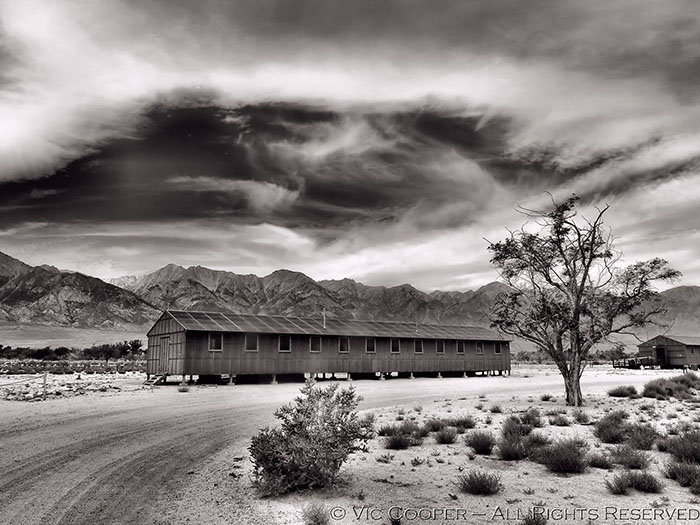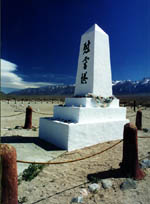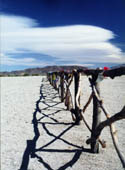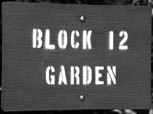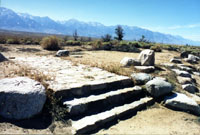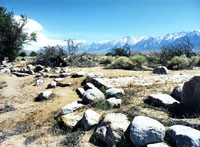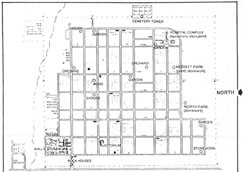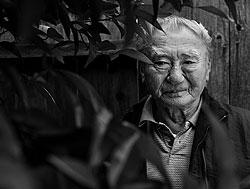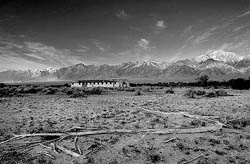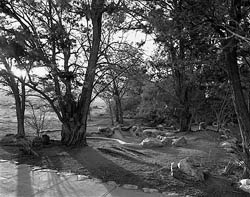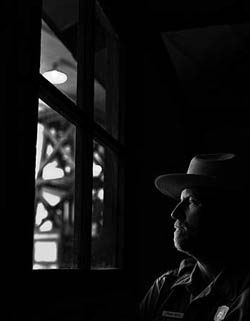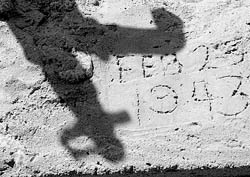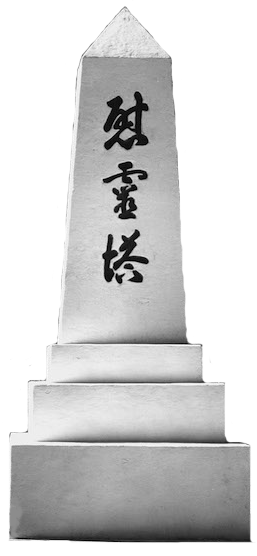















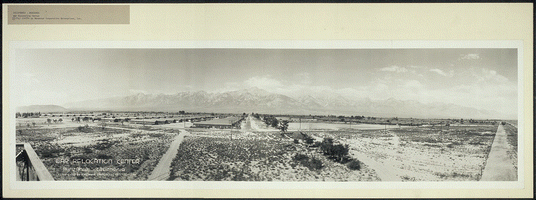
Copies of this panoramic photo of Manzanar can be obtained by contacting
See USE NOTICE on Home Page. |
![]()
![]()
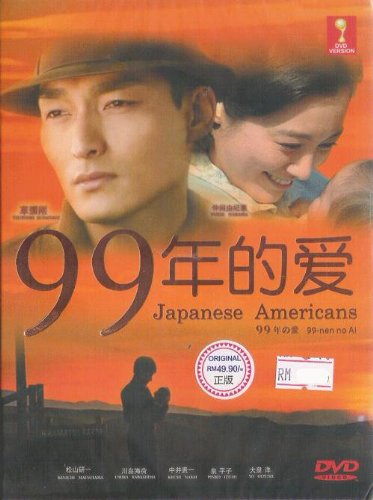 |
Japanese Americans: 99 Nen no Ai |
![]()
![]()
New
and Old facets of Manzanar |
Before Los Angeles siphoned off all of the water in Owens Valley, before the Carson & Colorado Railroad, before the internment of our own Japanese American citizens, before the mining, sheep, cattle and agricultural pioneers, the area of Manzanar was used for centuries by the native Shoshone and Paiute Indians. It wasn't until the early 20th century (around 1910) that the area of Manzanar developed into a thriving agricultural community. Remnants of these orchards are still visible today. Two months after the Japanese attack on Pearl Harbor in 1941 President Roosevelt signed the order to intern all people of Japanese ancestry. By March of the next year construction had begun on the Japanese internment camp at Manzanar located between Lone Pine and Independence in Owens Valley. Manzanar interned approximately 10,000 people (most of them American citizens) on some 6,000 acres of arid desert land. The facility consisted of the internment camp, agricultural use areas, a reservoir, airport, cemetery, and sewage treatment plant. Approximately 550 acres of this area was surrounded by barbed wire and guard towers containing the living area for the internees and various administrative facilities. All that remains of the camp are rock foundations, tumbleweeds, dead orchards and the forever-changed lives of those surviving 10,000 internees. The monolithic marker in the cemetery is an ever-present reminder of the final price that some Japanese Americans were required to pay just because of their cultural heritage. |
![]()
|
|
| Ray, Having driven past Manzanar many times over the last 30 years, I finally stopped and looked this past summer (2002). I found the remnants of the water gardens so compelling that I came back with a camera about a month later. Unfortunately, I couldn't do justice to the barren wasteland and scrub that is/was Manzanar. I've been searching the web this evening looking for pictures of those gardens as they were--so far no luck. They must have been beautiful and I have been filled with admiration for the artistry of their builders. I remember the stone circle with the cement cap and the phrase 'built by Wada and Crew' along with the date and the signatures of the crew. I can't describe it exactly, but having a name on the stonework suddenly made for a sharper connection for me. Who was Wada? What happened to him? When I saw the letter from his granddaughter here in San Diego I felt glad to know that he lives on through her. Charlie Mulcahy's story of his friend Saburo Seko would have been another touching account but for the phrase "How the Jews came into their village and paid them pennies on the dollar for their home furnishings." I don't know what really happened; Whether the people that took advantage of Mr. Seko were Jewish or whether Mr. Seko accepted prejudices which were common at that time. I do know that without the balancing accounts of other internees who were ripped off by THEIR neighbors, Mr. Mulcahy's story perpetuates a stereotype that is as repugnant to me as the phrase "Japs" would be to the descendants of Manzanar internees. I'm not sure I can clarify my feelings any better than that. Perhaps it rankles because it is not Mr. Seko's firsthand account but rather a story that is being retold by a non-Japanese-American who wasn't there at the time. Or, just as likely the reason it bothered me so much is that at Manzanar I tripped over my own stereotypes. When I visited the Manzanar cemetery it was July 4. I remember seeing lots of little American flags attached to the fence and thinking "Now why would there be American flags at a Japanese Cemetery...." and I remember feeling ashamed when I realized that I was thinking "Japanese", rather than "AMERICAN" citizens that were locked up because of their skin color. A fitting reminder for me that I've got some "scrubbing out" to do in my own head, and another reason it's important that Manzanar be remembered. Dave (October 2002) |
 |
Excerpt
from the Wednesday, December 11, 2002 Los Angeles. Pictures by Bryan Chan (LA Times photographer), story by Bettina Boxall (Times Staff Writer). The national park ranger pictured below is John Slaughter. |
Reassembling a Sad Chapter of History |
| Manzanar, Calif. - A piece of Manzanar came
home this week, trucked down U.S. 395 past the snowy teeth of
the Eastern Sierra to the empty flats on which it once stood. The return of the weathered mess hall building is a small milestone in a painstaking effort to tell an inglorious American war story: the 1942 roundup of 120,000 West Coast residents of Japanese descent and their internment in government camps. Ten thousand of them were sent here to a plain of stunning scenery, biting winter wind and searing summer sun, where they managed to fashion a community out of a charmless, instant town of tar-papered barracks ringed by barbed wire. The Manzanar War Relocation Center,as it was called, was dismantled after World War II, its 800 wooden buildings between Independence and Lone Pine taken apart or carted away for use by churches and local towns. Aside from a large auditorium later used by county road crews, a couple of deteriorating stone guard gates and a cemetery, not much was left except memories, some of them good, some of the bad. The National Park Service is slowly changing that, as it gathers the fading threads of the Manzanar story and endeavors to weave them into an enduring public display of America at its less than best. 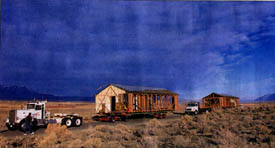 For most of the millions who have driven 395 over the past decades, Manzanar has been a barely noticed blur through the windshield on the way to the ski slopes of Mammoth Mountain or the campgrounds of Yosemite National Park. Even those who stopped and wandered past the camp's half-buried rock gardens or picked fruit from its old, wind-bent trees often had little sense of what happened here or what it meant. "I had no idea we interned 120,000 people. My mom didn't know," said John Slaughter, who grew up outside Los Angeles and as a teenager hunted quail and picked pears at Manzanar on family trips to the Eastern Sierra. He even had a favorite lunch spot, a rock sculpture built by internees for one of their gardens. But he never thought much about why the small granite boulders had been stacked in the middle of nowhere or who had stacked them. He became more curious while working as a civilian employee at the nearby China Lake Naval Weapons Center. Now the facility manager for the Manzanar National Historic Site, it is Slaughter's job to make the camp's history known. "The story really got to me," said Slaughter, 36, who lives in Ridgecrest. "I come from a very conservative family and was never told about that. Finding out our country was capable of doing that - I was ashamed. And I'm ashamed a lot of people don't know and don't get it." Chronicling Manzanar is no simple task. Many who lived here are dead, and the pool of aging internees shrinks every year. More critically, there is no single truth about Manzanar. There are many. For many, internment was a dreadful, humiliating experience, a brutal reminder of America's racism and its historic demonization of Asian immigrants. Families whose members had served in the U.S. Army, become American citizens and barely knew a word of Japanese were uprooted from their homes and businesses in the months after Pear Harbor and shipped to the Owens Valley, where the main product seemed to be dust. They lived in military-style barracks, stood in chow lines to eat, showered and went to the bathroom in communal latrines bereft of even a shred of privacy. But they also made a life here, sending off for mail-order furnishings to decorate their spartan quarters, pushing back the long wooden dining tables for Saturday night dances in the mess halls, planting their own victory gardens between barracks and even making illicit booze in secretly excavated cellars. "I have never felt bitter against the government," said George Izumi of Los Angeles, who was sent with his family to Manzanar when he was 21 and remembers the experience as relatively benign. Had Japanese Americans been left on the coast, he said, they probably would have been attacked and harassed because they looked like the enemy. "If someone had been killed on the street, no one would have cared. It just would have been another dead 'Jap,'" he said matter-of-factly. It is important, Izumi added, for the park Service to memorialize not only the camp, but what internees accomplished here. Many others describe Manzanar as a place of woe. In one of the booklets of camp recollections given to schoolchildren who visit the site, Rosie Maruki Kakuuchi paints a bleak picture. "The train ride to Manzanar was like we were being transported like a criminal. The shades were drawn as we left the city.... After the train ride we were bused into Manzanar Camp behind a barbed wires and sentry guards with machine guns. It was windy, dusty and miserable. 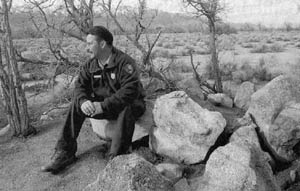 "We shared our room with two other families who were strangers," continued Kakuuchi, who was 16 when she arrived at Manzanar with her family. "There was no privacy, only sheets hanging, separating each family.... As a teenager, one of the hardest things to endure was the communal latrines with no partitions and showers with no stalls. This situation was embarrassing, humiliating and degrading." Some families spent the duration of the war at the camp; others were allowed to move to cities in the interior of the U.S.; and some men signed up for military service. Designated a national historic site in 1992, Manzanar is overseen by a tiny staff with a small budget. Slaughter's office is a trailer at the camp. park rangers work out of cramped offices in nearby Independence. In the last few years they have conducted focus groups and invited the public to inspect and comment on planned exhibits. They have gathered binders of camp photos taken by Dorothea Lange for the War Relocation Authority and others taken by internee Toyo Miyatake. They have recorded long interviews with former internees and people who worked at the camp. They have scoured old real estate brochures and newspaper articles for mention of Manzanar in the early 1900s, when it was promoted as an orchard man's paradise. That was before the Los Angeles Department of Water and Power bought up rights to the valley's water and piped it south to the city [Los Angeles]. And they have hunted for Manzanar buildings that have not been bastardized. "A lot of the buildings have been modified beyond the ability to restore," Slaughter said. "We get calls all the time from people who say 'I've got an old Manzanar building.' And it's been converted into a duplex with two bathrooms - it used to be a Manzanar building." The mess hall, moved to Bishop after the war, is a comparative gem. It was used for a few years as an infirmary by a military training group stationed at the Bishop airfield and later became a clubhouse for a sand golf course scratched out of the sagebrush next to the airstrip. "I think it was more of a drinking society than anything," Owens Valley native Fred Phillips, who works on the camp maintenance crew, said with a chuckle. The building was subsequently used for storage and then abandoned. But it was never carved up. The kitchen area still contained the huge original iron stove used by camp cooks, as well as the walk-in cooler. What's more, Inyo County was willing to donate the structure to the Park Service. "Generally, what we hear is, 'I have a building, how much will you give for it?'" Slaughter said. "And that's not what we're about. We don't want to get in the real estate business, buying up old buildings." Two sections of the hall were transported the 45 miles from Bishop on Monday by a Southern California house-moving company. The other half was scheduled to be trucked down today. The parts will be joined together at a spot near the old camp auditorium, which is undergoing a $5.2 million conversion into a visitors center scheduled to open late next year. Along with the mess hall, the Park Service hopes to erect a couple of original barracks and reconstruct some outbuildings to create a small demonstration block that will provide visitors a glimpse of Manzanar life. "It really helps bring back a flavor of what the site must have looked like," Manzanar superintendent Frank Hays said after the first two sections of the mess hall arrived at Block 14. "It's only one building on a pretty flat expanse, but it does help you imagine what it was like." |
![]()
Bones Found Near Mt. Williamson May Be Those of Giichi Matsumura
![]()
Dark Era Remembered by Sam Stanton |
![]()
![]()
|
|
Simply type in the word Manzanar and let the search begin. |
|
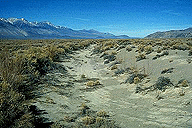
Dry ditch at the site of Manzanar
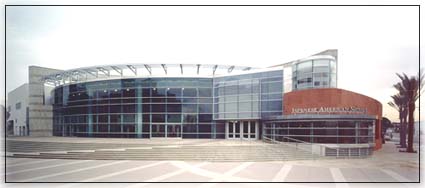 369 East First Street, Los Angeles, California 90012 phone: (213) 625-0414, fax: (213) 625-1770 |
|
|
20-Mule-Team History | |
|
|
WW2 War Relocation Authority Center History | |
|
|
Manzanar High School Portraits & History | |
|
Manzanar Journal - Berry Tamura |
|
|
Manzanar Free Press |
|
|
Manzanar Town, Owens Valley |
|
Sign Guestbook View Old Guest Book Entries Oct 1999 - Feb 2015 (MS Word) |
 CONTACT the Pigmy Packer |
View Guestbook View Old Guest Book Entries Oct 1999 - Feb 2015 (PDF) |
